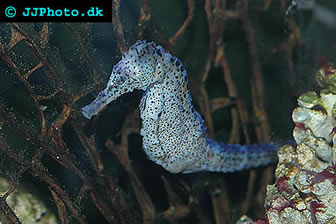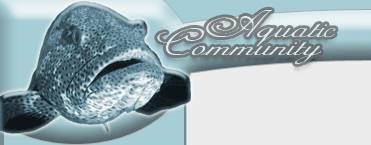Lined Seahorse
Hippocampus erectus

The Lined Seahorse, Hippocampus erectus, is known under several other names in English, including Northern Seahorse and Spotted Seahorse. It belongs to the family Syngnathidae where you will find not only seahorses but also pipefish, weedy sea dragons and leafy sea dragons.
Conservational status
Hippocampus erectus is listed as Vulnerable (VU) on the IUCN Red List of Threatened Species and the international trade is monitored through a licensing system (CITES II, since 5.15.04).
Hippocampus erectus is primarily threatened by habitat degradation and intentional and incidental capture. It is sought after in the aquarium hobby, sold as a souvenir, and used in traditional Chinese medicine. In China, it is believed to be a powerful aphrodisiac and it is also used to treat various health problems such as infertility, throat infections and asthma.
You can find more information here: ttp://www.iucnredlist.org/search/details.php/10066/all
Geographical range, habitat and habits
The Lined Seahorse is found in the Western Atlantic, from the southern tip of Nova Scotia in Canada, North America down to Venezuela in South America. It is for instance present along the eastern coasts of USA and Mexico as well as in the Caribbean Sea. Its geographical range stretches from 50°N to 5°N and from 97°W to 40°W. The Lined Seahorse is not a migratory species but it will move to deeper waters during the colder season. Its dept range is 1-73 meters / 3.3-240 feet.
The Lined Seahorse is typically found in coastal waters and likes to stay close to coral reefs and man made structures such as piers. It is normally attached to gorgonians or sea grasses, but can also swim around freely or live among floating Sargassum. Specimens hiding in Sargassum are normally equipped with bony protuberances and fleshy tabs which serve to keep them camouflaged.
The Lined Seahorse is not a strong swimmer and it needs a lot of time to transport itself even when the distance is short. It will rapidly move its dorsal and pectoral fins to propel itself.
Size and appearance
The largest scientifically measured Lined Seahorse was 19 cm / 7.5 in from the top of its coronet to the tip of its straightened tail.
Just like the other seahorses, the Lined Seahorse doesn’t look like a typical fish at all. It swims upright and its head – which set at a right angle to the body – looks more like the head of a horse than of a fish. Instead of scales, the body of the seahorse is protected by rings consisting of about 50 rectangular bony plates. Another interesting feature is the eyes which can swivel independently or converge to achieve binocular vision.
The Lined Seahorse is equipped with a prehensile tail that comes in handy when the fish needs to hold on to coral, seaweed or similar in the ocean. During the first two weeks of its life, the sea horse is so agile that it can bend its tail backward into a reverse crescent. It is however only capable of holding on to things when the tail is bent forward. Adult seahorses are not as agile as the young ones and they will normally keep the tail coiled forward and only rarely hold it in a straight position (never backwards).
The Lined Seahorse features a pattern of dark lines on a lighter background and this makes it easy to tell it apart from other species of seahorse. The base colour varies and can be black, grey, brown, yellow, orange, or red. Specimens with a brown base colour are usually paler on the ventral side. The Lined Seahorse can be decorated with white lines that follow the contour of the neck. Some specimens have white dots on the tail and the dorsal surface can be adorned with “saddles”. Such “saddles” are often in line with the larger body rings.
A southern form of Hippocampus erectus has been found in Rio de Janeiro in Brazil and is believed to be so genetically distinct from Hippocampus erectus that it might actually be a separate species. More research is necessary before anyone can know for sure. This form might also be present in Suriname, but this has not been confirmed.
Lined Seahorse care
It is not advisable to keep Lined Seahorse in an aquarium smaller than 30 gallons / 115 litres. The seahorse need open areas to swim around in as well as plenty of good hiding spots. The Lined Seahorse is a slow and generally peaceful species and will not attack other fish in the aquarium.
Do not get a Lined Seahorse unless you know how to keep the environment stable and the water quality up in a saltwater aquarium. The specific gravity should be kept in the 1.020-1.025 range and the pH-value between 8.1 and 8.4. The recommended water temperature is 72-78° F / 22-25.5° F.
Feeding Lined Seahorse
The Lined Seahorse feeds by using its long snout as a pipette and suck in tiny animals. It is not fast enough to chase after prey.
You need to provide your Lined Seahorse with live food in the aquarium. Keep the diet varied to ensure optimal health. You can for instance give your seahorse mosquito larvae, brine shrimp, mysis shrimp, grass shrimp and daphnia. Serve several small portions throughout the day instead of just one or two larger meals. Young Lined Seahorses can spend up to ten hours a day feeding and devour thousands of small shrimps.
Breeding Lined Seahorse
The breeding habits of seahorses are fascinating and watching them breed in the aquarium is a highly rewarding experience. The seahorse is a monogamous species and once a pair has been formed they will mate with each other only until separated by death. Each morning, they will carry out greeting dances to confirm their union. When a seahorse dies or is removed from the ocean, its partner is very slow to find a new mate.
The Lined Seahorses will not only dance in front of each other; they are also known to use sounds to communicate with each other. When they mate, they will swim slowly and produce certain snappy or clicking sounds. The will often click alternately during the initial face. During the actual mating, the sounds will be almost continuous and really loud.
How can the Lined Seahorse produce these strange noises? At the back of its head, the seahorse has a bony crest shaped as a star. This crest is called coronet and has a loose articulation with the rear edge of the skull. If the seahorse suddenly lifts its head, an edge will slip under the coronet, and when the head is lowered again, the edge will snap out with a clicking/snapping sound. The seahorse can therefore be seen tossing its head while producing the sounds to its partner.
The Lined Seahorse is an egg-laying species. The eggs will be placed in a closable brooding pouch located on the lower side of the tail of the male fish and they are fertilized inside this pouch. Sexing Lined Seahorses is fairly easy since the female fish has no breeding pouch.
During the actual spawning, the female seahorse will spray 250-650 eggs into the pouch. (The exact number of eggs depends chiefly on her size.) The eggs are fertilized by the male and will develop inside the pouch for roughly three weeks. When the eggs hatch, the embryos will stay inside the pouch until they have developed enough to swim comparatively free in the water.
Carrying around the offspring inside the pouch is risky for the male, because it is not uncommon for young ones to die inside the pouch. A dead animal will eventually result in gas formation and this will turn the male into a balloon. The trapped gas will force the father up to the surface where he will be an easy catch for all sorts of predators, e.g. hungry sea birds.
When it is time to release the offspring from the pouch, the male seahorse will hold on to a plant stem or similar with his tail and start bending rapidly back and forth. For each bend, one seahorse will be released with its head first. The male fish will continue to bend back and forth until all the fry have been released.
When the seahorse fry is released, it has developed into a miniature copy of the adult fish and is typically 1.5 cm in length (roughly 5/8 of an inch).
As mentioned above, Lined Seahorse has been successfully bred in aquariums. Since this species is listed as vulnerable on the IUCN Red List of Threatened Species, it is best to stick to captive bred specimens and avoid depleting the wild populations by purchasing wild caught ones.
Seahorse Articles:
Sea horses in Aquarium - An article about how to keep sea horses in aquariums.Common Seahorse – A guide to keeping Hippocampus kuda
Long Snout Seahorse – A guide to keeping Hippocampus reidi
